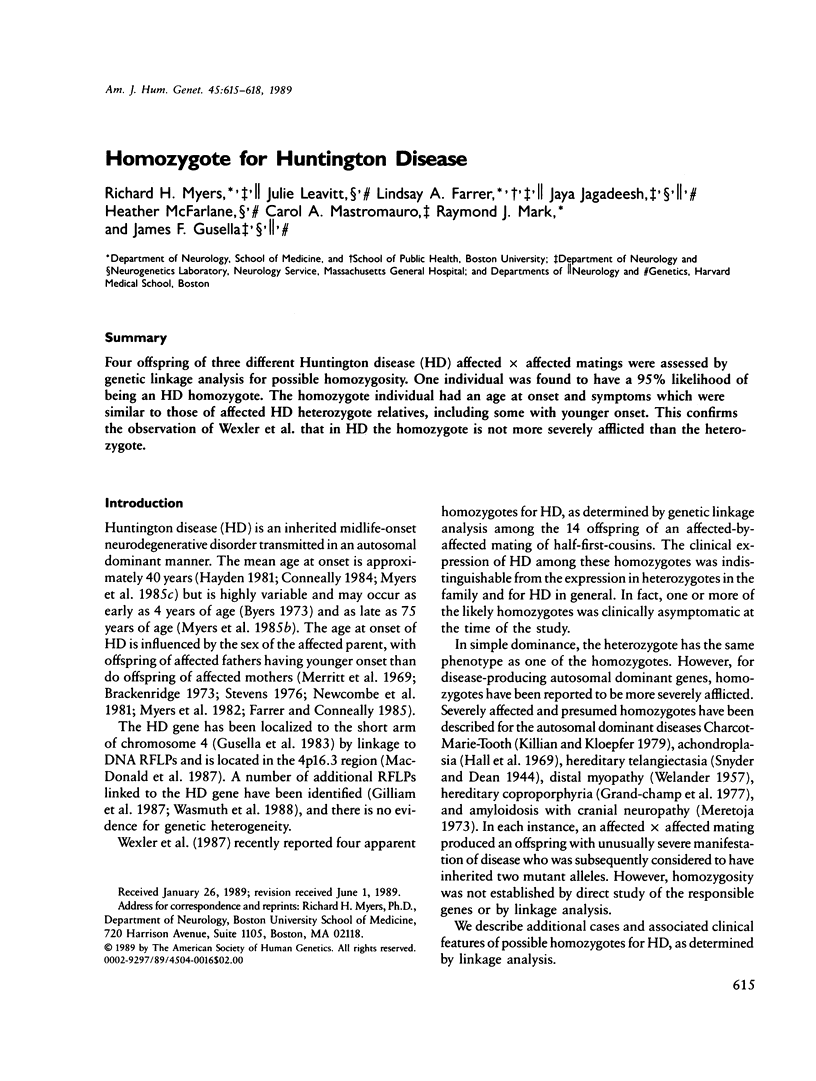Homozygote for Huntington disease (original) (raw)
. 1989 Oct;45(4):615–618.
Abstract
Four offspring of three different Huntington disease (HD) affected x affected matings were assessed by genetic linkage analysis for possible homozygosity. One individual was found to have a 95% likelihood of being an HD homozygote. The homozygote individual had an age at onset and symptoms which were similar to those of affected HD heterozygote relatives, including some with younger onset. This confirms the observation of Wexler et al. that in HD the homozygote is not more severely afflicted than the heterozygote.

Selected References
These references are in PubMed. This may not be the complete list of references from this article.
- Brackenbridge C. J. The relation of sex of affected parent to the age at onset of Huntington's disease. J Med Genet. 1973 Dec;10(4):333–336. [PMC free article] [PubMed] [Google Scholar]
- Byers R. K., Gilles F. H., Fung C. Huntington's disease in children. Neuropathologic study of four cases. Neurology. 1973 Jun;23(6):561–569. doi: 10.1212/wnl.23.6.561. [DOI] [PubMed] [Google Scholar]
- Conneally P. M. Huntington disease: genetics and epidemiology. Am J Hum Genet. 1984 May;36(3):506–526. [PMC free article] [PubMed] [Google Scholar]
- Farrer L. A., Conneally P. M. A genetic model for age at onset in Huntington disease. Am J Hum Genet. 1985 Mar;37(2):350–357. [PMC free article] [PubMed] [Google Scholar]
- Farrer L. A., Myers R. H., Cupples L. A., Conneally P. M. Considerations in using linkage analysis as a presymptomatic test for Huntington's disease. J Med Genet. 1988 Sep;25(9):577–588. doi: 10.1136/jmg.25.9.577. [DOI] [PMC free article] [PubMed] [Google Scholar]
- Gilliam T. C., Bucan M., MacDonald M. E., Zimmer M., Haines J. L., Cheng S. V., Pohl T. M., Meyers R. H., Whaley W. L., Allitto B. A. A DNA segment encoding two genes very tightly linked to Huntington's disease. Science. 1987 Nov 13;238(4829):950–952. doi: 10.1126/science.2890209. [DOI] [PubMed] [Google Scholar]
- Grandchamp B., Phung N., Nordmann Y. Homozygous case of hereditary coproporphyria. Lancet. 1977 Dec 24;2(8052-8053):1348–1349. doi: 10.1016/s0140-6736(77)90386-5. [DOI] [PubMed] [Google Scholar]
- Gusella J. F., Wexler N. S., Conneally P. M., Naylor S. L., Anderson M. A., Tanzi R. E., Watkins P. C., Ottina K., Wallace M. R., Sakaguchi A. Y. A polymorphic DNA marker genetically linked to Huntington's disease. Nature. 1983 Nov 17;306(5940):234–238. doi: 10.1038/306234a0. [DOI] [PubMed] [Google Scholar]
- Harper P. S., Dyken P. R. Early-onset dystrophia myotonica. Evidence supporting a maternal environmental factor. Lancet. 1972 Jul 8;2(7767):53–55. doi: 10.1016/s0140-6736(72)91548-6. [DOI] [PubMed] [Google Scholar]
- Lathrop G. M., Lalouel J. M., Julier C., Ott J. Multilocus linkage analysis in humans: detection of linkage and estimation of recombination. Am J Hum Genet. 1985 May;37(3):482–498. [PMC free article] [PubMed] [Google Scholar]
- MacDonald M. E., Anderson M. A., Gilliam T. C., Tranejaerg L., Carpenter N. J., Magenis E., Hayden M. R., Healey S. T., Bonner T. I., Gusella J. F. A somatic cell hybrid panel for localizing DNA segments near the Huntington's disease gene. Genomics. 1987 Sep;1(1):29–34. doi: 10.1016/0888-7543(87)90101-7. [DOI] [PubMed] [Google Scholar]
- Meretoja J. Genetic aspects of familial amyloidosis with corneal lattice dystrophy and cranial neuropathy. Clin Genet. 1973;4(3):173–185. doi: 10.1111/j.1399-0004.1973.tb01140.x. [DOI] [PubMed] [Google Scholar]
- Miller M., Hall J. G. Possible maternal effect on severity of neurofibromatosis. Lancet. 1978 Nov 18;2(8099):1071–1073. doi: 10.1016/s0140-6736(78)91804-4. [DOI] [PubMed] [Google Scholar]
- Myers R. H., Cupples L. A., Schoenfeld M., D'Agostino R. B., Terrin N. C., Goldmakher N., Wolf P. A. Maternal factors in onset of Huntington disease. Am J Hum Genet. 1985 May;37(3):511–523. [PMC free article] [PubMed] [Google Scholar]
- Myers R. H., Madden J. J., Teague J. L., Falek A. Factors related to onset age of Huntington disease. Am J Hum Genet. 1982 May;34(3):481–488. [PMC free article] [PubMed] [Google Scholar]
- Myers R. H., Sax D. S., Schoenfeld M., Bird E. D., Wolf P. A., Vonsattel J. P., White R. F., Martin J. B. Late onset of Huntington's disease. J Neurol Neurosurg Psychiatry. 1985 Jun;48(6):530–534. doi: 10.1136/jnnp.48.6.530. [DOI] [PMC free article] [PubMed] [Google Scholar]
- Myers R. H., Schoenfeld M., Bird E. D. Huntington's disease: genetics, chemical pathology, and management. Prog Med Genet. 1985;6:91–122. [PubMed] [Google Scholar]
- Newcombe R. G., Walker D. A., Harper P. S. Factors influencing age at onset and duration of survival in Huntington's chorea. Ann Hum Genet. 1981 Oct;45(Pt 4):387–396. doi: 10.1111/j.1469-1809.1981.tb00352.x. [DOI] [PubMed] [Google Scholar]
- WELANDER L. Homozygous appearance of distal myopathy. Acta Genet Stat Med. 1957;7(2):321–325. doi: 10.1159/000150998. [DOI] [PubMed] [Google Scholar]
- Wexler N. S., Young A. B., Tanzi R. E., Travers H., Starosta-Rubinstein S., Penney J. B., Snodgrass S. R., Shoulson I., Gomez F., Ramos Arroyo M. A. Homozygotes for Huntington's disease. Nature. 1987 Mar 12;326(6109):194–197. doi: 10.1038/326194a0. [DOI] [PubMed] [Google Scholar]